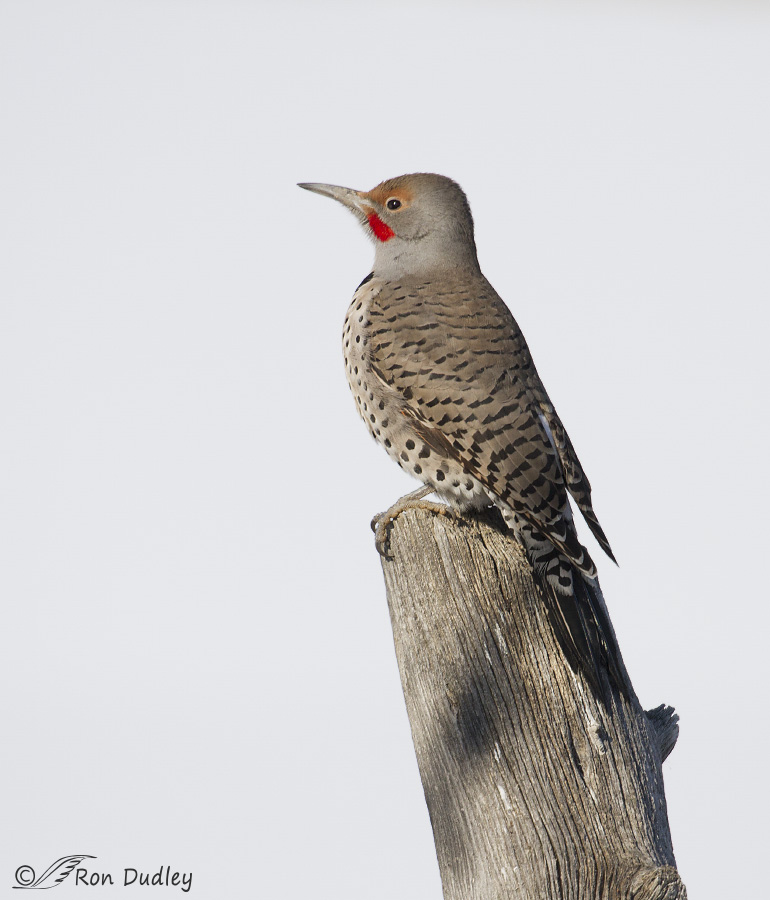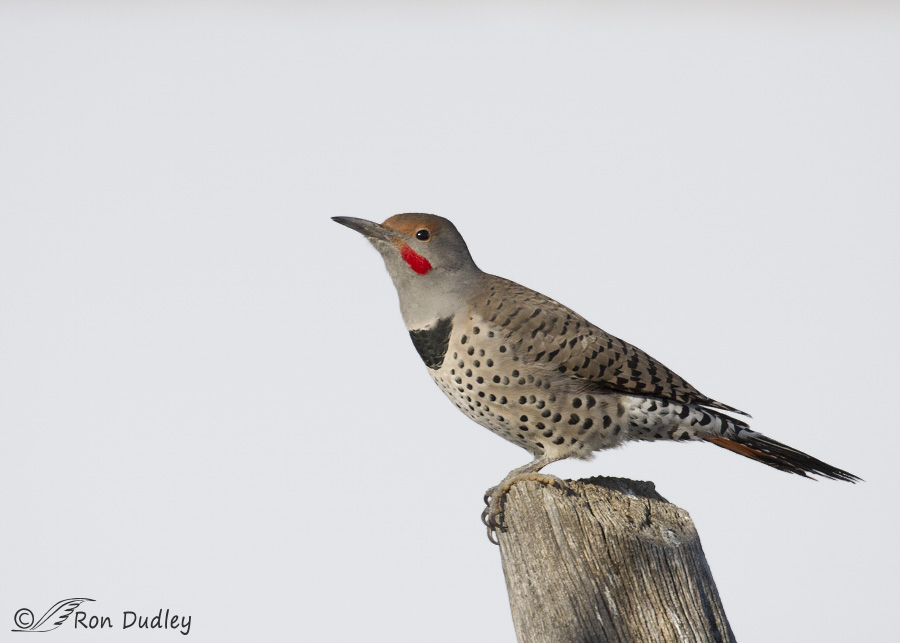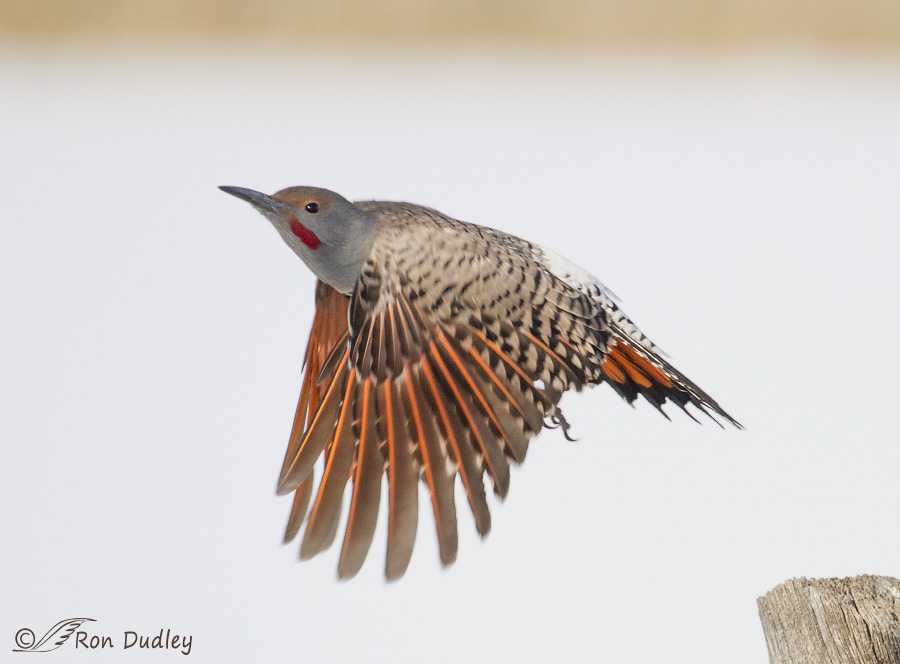“High-key” images have a predominance of light or bright tones which in this case were provided by an ice and snow-covered pond in the background.

1/2000, f/6.3, ISO 500, Canon 7D, Canon EF 100-400mm f4.5-5.6L IS II USM @ 400mm, not baited, set up or called in
The pond was Glover Pond in Farmington, Utah and the subject was a nervous adult male Northern Flicker (images taken 6 days ago). I can seldom get close to flickers but I believe this bird was torn between flight to escape my approaching pickup and wanting to remain close to yet another flicker in a small tree just a few feet out of frame to the left. For the moment the bird chose to remain on the post.
I’m not a fan of high-key backgrounds when they’re caused by white clouds – they’re usually just too bright and white for my tastes. But there’s enough blueish tone in this ice and snow to make these images palatable for me.

1/2500, f/6.3, ISO 500, Canon 7D, Canon EF 100-400mm f4.5-5.6L IS II USM @ 400mm, not baited, set up or called in
Naturally I only had a few seconds with this bird before another vehicle approached so the flicker turned and crouched slightly as it prepared to take off. I didn’t have enough time to adjust camera settings for flight and I needed to, especially since I was quite close to the bird (with my smaller lens) and the lighting was tricky so I didn’t have high hopes for any take-off shots I might get. And I was right.

1/2500, f/6.3, ISO 500, Canon 7D, Canon EF 100-400mm f4.5-5.6L IS II USM @ 400mm, not baited, set up or called in
I didn’t have quite enough shutter speed or depth of field to get the left wing sharp and the lighting on different parts of the bird was highly variable so I had to make more exposure adjustments on this image during processing than I like to.
Even after all that the photo still isn’t a great one but I do think it’s quite interesting visually. This is one of the few bird images I can think of where my attention isn’t first drawn to the face and eye. Instead it goes to those amazing colors on the wing and tail that we normally don’t see in the perched bird.
Ron
PS – the band of color at the top of the last image is the back edge of the pond.


Sent Ron!?
Charlotte
I just had a flicker on my pine tree the other day. He or she came in for the suet I put out. That wing photo is amazing.
Sensational shots Ron!
Charlotte
Oh man, I need my sunglasses again hehe..Beautiful bird shots Ron.
Thank you, Jean.
Patty is soooooo right about your culling.
Yes, the head and the eye are important. And awe inspiring and frequently very, very beautiful. Like so much else. The apparent textures, the colours – subtle or vivid, the talons, the britches, the majesty… And the list goes on.
Your less than perfect (hear me blow raspberries) shot is so reminscent of the very best fans that we poor humans try and create. A piece of Japanese art. And the colours are incredible.
“is so reminscent of the very best fans that we poor humans try and create”
That’s an interesting parallel, EC. Hadn’t thought of it but you’re right.
Loved your raspberries!
I feel the motion this bird is engaging as I view the photo’s. I love this series of pictures as you once again proved how much you love what you are searching for while taking these photographs. Wonderful.
You’re absolutely right, Ellen. I do love both the process of photography and my primary subjects – birds.
Your less than flattering comments about the quality of the third shot (which I find magnificent) is why I get anxious about your “culling”…whereas I find that shot amazing, I find the orher two almost equally so…the first is a “classic”, the second is very appealing, almost my favorite, and the third speaks for itself. I always backpacked with my lucky Flicker feather tucked into the headband of my red “Crusher” hat, along with a clevis pin, a toggle, some safety pins, a couple of bandaids, a small packet of waterproof, windproof matches and some birchbark and waxed lint…….probably because I had them, I never needed any of them…except for the lucky feather…..
Sounds like you were a hard-core backpacker and hiker in your day, Patty. That must explain at least part of why you’ve had so many experiences that relate to topics I cover in my blog.
These shots are very nice Ron, love the one flying – super!!
Being an old guy, I have a hard time sometimes with either being politically correct or changing some names!
I still look at this flicker and see Red-shafted Flicker, rather then the normal Northern Flicker. It is the same with Old Squaw and Long-tailed Duck.
Dick..isn’t there a yellow-shafted Flicker, too…mine is yellow where I realized this one is red…or maybe all this time, I’ve been thinking of the wrong bird…
Yes Patty, here in the east we have the Yellow-shafted Flicker and in the west we have the Red-shafted Flicker. The predicament that the taxonomists were in was the movement of the Red-shafted to the east and the Yellow-shafted to the west when telephone poles and trees were planted across the Great Plains. Now that the grasslands of America had trees and poles both woodpeckers (Flickers) could interact and mate producing hybrids. So, as a biologists I understand why the taxonomists had to change the name to Northern Flicker, Red-shafted race and Yellow-shafted race, but when I see those red shafts to the primaries I have to think that the name Red-shafted Flicker is quite appropriate.
Plus, the Red-shafted Flicker has a red mustache, not black as in the Yellow-shafted Flicker.
You did a nice job explaining the taxonomic challenges that flickers present, Dick. In my classes I always used to use the hybridization of Red-shafted and Yellow-shafted Flickers as an example of the difficulties of pinning down species.
Dick, Ron–Thank you both…my Lucky Feather is yellow-shafted…
All of the images are great, but the in-flight photo is truly amazing and wonderful! That N. Flicker is shouting, “Look at me! Aren’t I beautiful”
Made my day!!
“That N. Flicker is shouting, “Look at me! Aren’t I beautiful”
I’ve always wondered what the real evolutionary purpose of those colors is, Jane – especially because they’re mostly only seen in flight.
I, too, gasped out loud at the gorgeous color in the last shot ; I’ve always admired and watched Flickers, but until this morning, I had no IDEA what
colors they were “hiding”—-thanks for this viewing .
And they hide those colors well, Kris. You usually have to be at least a little lucky to capture them.
I love the color in their wings and they are hard to get close to – except, of course, when they’re hammering on a building! The background while accenting the bird, is amazingly plain. Good work, Ron.
The background while accenting the bird, is amazingly plain. Good work, Ron.
Judy, I know what you mean. They occasionally hammer on my wooden house just above my bedroom window at the peak of the eaves. And they start VERY early in the morning…
Very beautiful images Ron. They are such amazing birds, and yet because I see them frequently I somehow do not end up taking many photos of them — like magpies. Whenever I see your images of both these species though, I am reminded just how beautiful they both are. The last image is interesting that 1 /2500 sec still shows a little movement at the wing tip. I actually like that movement in your image since it conveys motion balanced against tack sharp focus on the flickers eye and bill. Do you know that determines a “Red Shafted Northern Flicker” versus a “regular” Northern Flicker? I will have to re-learn that since I have forgotten. Thanks for the inspiration to pay more attention to these beauties.
“Do you know that determines a “Red Shafted Northern Flicker” versus a “regular” Northern Flicker?”
Here’s the way I understand it – “regular” Northern Flickers include both Red-shafted and Yellow-shafted Flickers as subspecies. The similar Gilded Flicker is considered a separate species. For the moment… I think…
Ron, I believe the Gilded Flicker was specific to its habitat in southern AZ and Baha, but mates with the Red-shafted race of the Northern Flicker, thus hybrids have been found which suggests that the Gilded will be considered a sub-species as well in the future.
We have flickers here but I never saw those wonderful colors on the wings – a great gift!
Those colors are always a wonderful surprise when you get to see them for an instant, Alison – but it never lasts long…
OMG, Ron – the last photo is amazing. What beautiful coloring on those wings!! I’d never seen a Flicker until I started following your blog so I’m extremely happy you shared these photos today. What a beautiful sight to start my day!!
That color is pretty spectacular, isn’t it, Jo Ann. Usually I only see flashes of it as a flicker flies away from me so it was a treat to capture it in an image, imperfect as it is…
Ron–How can you not be thrilled to pieces with that third flight photo????????
Patty, I do like the shot or I wouldn’t have posted it. To be “thrilled to death” though, that wing would have to be sharper, esp up high where it attaches to the body.